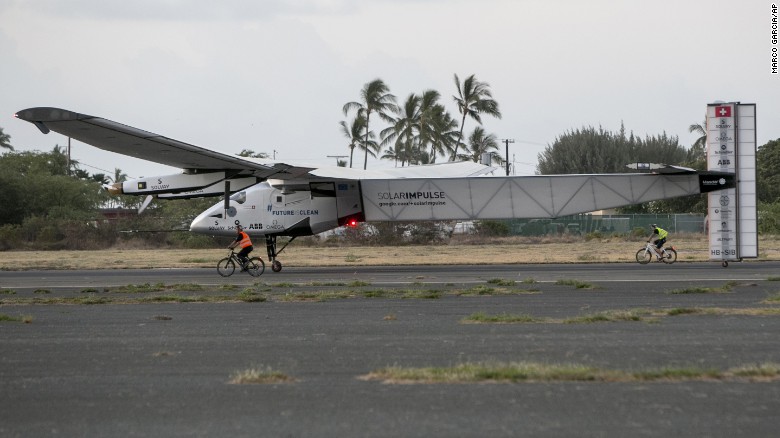
Solar Impulse 2’s attempt to fly around the world without a drop of fuel has been delayed by serious battery damage, raising questions over whether the experimental plane’s mission can be completed before the days get too short.
The batteries that store the solar-powered aircraft’s energy overheated on the latest leg of the journey, from Nagoya in Japan to Hawaii, and will need to be replaced.
The team says repairs are likely to take “several weeks,” adding that they “[do] not see the possibility for any flights before two to three weeks at the earliest.”
But the latest hold-up may mean there isn’t time to fly all the way back to base in Abu Dhabi before the Northern Hemisphere’s days become too short to provide enough power to keep the plane flying.
Solar Impulse 2 relies on there being enough hours of daylight to gather all the energy it needs — in more than 17,000 solar cells which cover its fuselage and wings — to fly on through the night, usually at speeds no faster than a normal car.
Speaking to CNN last month during an unscheduled stop on the marathon journey, pilot Andre Borschberg admitted there was a chance the plane may not make it back before the change of seasons ruins the team’s plans.
“There are chances that we can make it,” former fighter pilot Borschberg said. “But there are risks also that we can’t make it on time … We ate our margin.”
Delays have already taken their toll on the Solar Impulse team’s plans — the plane was grounded in China for two months earlier in the year, and bad weather forced it to turn back and land in Japan during the first attempt to fly to Hawaii.
From Hawaii, Solar Impulse 2 is due to fly to Phoenix, Arizona, and over the United States before crossing the Atlantic Ocean and stopping in North Africa or Southern Europe on its way back to the Middle East.
Borschberg and fellow pilot Bertrand Piccard take it in turns in the 3.8-cubic-meter cockpit, strapped into a special seat that serves both as bed (it reclines, allowing them to do essential exercises and to rest) and toilet.
They have been trained in meditation and self-hypnosis, to allow them to concentrate for lengthy periods, and yoga to help them relax in the plane’s confined space.
The aircraft is also equipped with oxygen bottles, a parachute and a life raft in case it gets into trouble and the pilot is forced to ditch midflight.
Borschberg flew the first leg of the journey, from Abu Dhabi to Oman, and the longest section, across the Pacific Ocean. Piccard will tackle the Atlantic crossing and bring the plane in to land back in Abu Dhabi on its “homecoming” flight.
Adventurer Piccard, who was part of the first team to circumnavigate the globe nonstop in a balloon in 1999, is also due to fly the next section of the journey, once the batteries are repaired.
Solar Impulse’s 72-meter (236-foot) wingspan makes it wider than a Boeing 747, but the plane weighs just 2.5 tons, lighter than a large SUV. Its round-the-world mission is intended to raise awareness about the potential of solar power.
As reported by CNN
